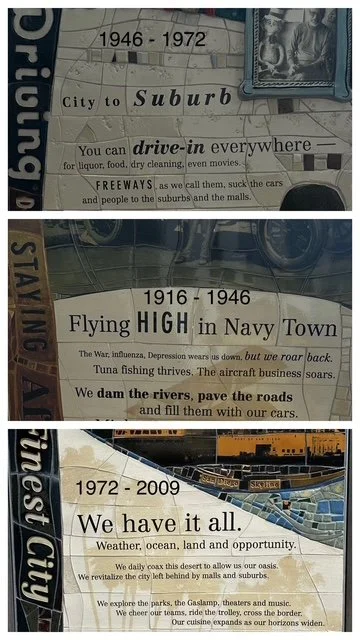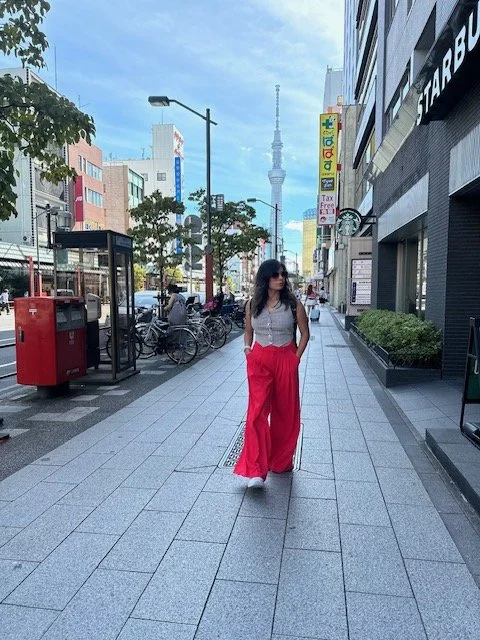The Walking Artist’s: Why I love walkable cities
There’s a simple joy in stepping outside and immediately joining the rhythm of city life on foot. In that moment, the city feels alive and welcoming. Walkable cities and neighborhoods matter and here’s my perspective on why I am so passionate about walkability (walking, biking, public transit).
Walking to me is a social experience, walkability helps turn streets into little communities. Neighbors pause to chat outside a cafe; kids play on the sidewalks; businesses and vendors become familiar faces. I've experienced this first hand when we lived in the ‘Belmont Shore’ community of Long Beach. Research backs this up: adults who live in walkable neighborhoods are more likely to interact with neighbors and feel a stronger sense of community than those in car-dependent areas. The simple act of being out on foot creates opportunities for friendly hello’s and serendipitous conversations that just don’t happen when everyone’s in cars. Wouldn't a walk with your dog for a morning coffee be more enjoyable than a drive-in?
Walkable neighborhoods look appealing. Think of a charming, narrow street in an old town, or a boulevard with wide sidewalks and benches. These places invite you to slow down and enjoy the scenery. By contrast, car-centric areas often feature seas of asphalt parking lots and hulking garages that can make any place look drab. ‘Transitguy’ account on instagram talks exactly about this. City planner Jeff Speck famously noted how many downtowns in the 20th century destroyed their own beauty by paving over historic buildings for parking - until “places that were easy to get to [were] not worth arriving at” anymore. It’s a telling image: beautiful architecture and lively plazas replaced with rows of parked cars, leaving little for the eye to admire or the soul to connect with. Nobody travels the world to see a great parking lot.
Thought provoking murals near my place in San Diego. We designed all neighborhoods around a car-friendly life, we paved the roads and filled cities with parking lots.
As we step into the new era, we are rethinking communities and step by step
Walkable streets also let the unique history and architecture of a place shine. When you’re on foot, you can appreciate the details on building facades, from ornate carvings to quirky shop signs, that whiz by unnoticed in a car. Walking enhances your ability to notice the layers of a city’s story: the mix of old and new buildings, the monuments or murals that mark important events, Public art also thrives in places where pedestrians roam. From eye-catching graffiti art to sculptures in the park, art is meant to be experienced up close, at a human pace. One charming example is the “long beach mural …Personally, this is one of my favorite walk times - I disconnect from the everyday demands of life by losing myself on the streets admiring historical architecture, colorful murals and discovering hidden gems! Designing a city for walking tends to make it prettier!
One of the biggest advantages of a walkable lifestyle is how it quietly improves your health. In a neighborhood where walking (or biking) is safe and convenient, staying active becomes part of your routine. You walk to catch the bus, to pick up groceries, or just to get some fresh air. The physical benefits are impressive: walking burns calories, strengthens the heart, and can reduce the risk of conditions chronic diseases. One study of California cities showed that more walkable street networks were associated with lower rates of obesity and diabetes among residents. It makes sense – if your environment encourages you to move around, you’re less likely to lead a sedentary lifestyle. Walking is not just good for the body; it’s a tonic for the mind. Have you ever taken an evening walk to clear your head? Science supports that feeling: walking raises endorphin levels and lowers stress hormones like cortisol, improving mood and even sleep quality. Longer daily commutes by car, in contrast, are linked to higher stress and lower happiness. Being on foot also reduces feelings of isolation. Being a scientist in the health and wellness space, I cannot stress enough the importance of movement in everyday routine.
You can pause to peek into a bookstore window or detour down an intriguing alleyway on a whim. This spontaneity is part of the joy of travel and urban exploration. Tourists often say the best way to discover a city is on foot, and locals too find that walking lets them see their hometown with fresh eyes.
Travelers love cities that they can easily explore on foot or via transit, and they often stay longer and spend more in such places. Think of the world’s great tourist destinations: many are eminently walkable – from the historic streets of Paris and Kyoto to the vibrant markets of Istanbul.
This is me in Berlin enjoying the sights and sounds of the city on foot and S-Bahn.
It’s hard to talk about walkable neighborhoods without also mentioning public transportation, the vital partner that extends the range of your feet. Even the most enthusiastic walker needs to occasionally travel across town or to a different part of the region. That’s where good transit comes in. In cities like Copenhagen, Singapore, or London, an excellent network of buses, trains, or trams complements pedestrian life. I wish I had the option of taking public transit for work everyday but unfortunately California is not designed for that. I’m optimistic though that many urban planning concepts are designing with the “15-minute city” concept in mind! Public transportation, in essence, expands the walkable map of your life. For instance, Helsinki, Finland has a bold plan to eliminate the need for most car trips by 2050 by improving transit to the point that walking+transit can cover virtually all daily needs.
From the busiest global cities to small towns, a movement is growing to make our neighborhoods more walkable and transit-friendly. When we design places for people instead of just for cars, life simply gets better. Streets become prettier and more engaging, communities grow closer, and individuals become healthier and happier!
Life at “walking speed” encourages us to notice and appreciate our surroundings, to feel connected to other people around us, and to be present in the here and now. In a fast-paced world, that slower, human pace can be truly enriching. Whether you’re a traveler exploring a new city’s alleyways or a resident rediscovering your own hometown block by block, the ability to walk and wander is a gift. It’s the city’s way of opening itself up to you. So the next time you have a chance, take a stroll through a neighborhood – listen to the local sounds, peek into courtyards, chat with a shop owner, ride the tram to the next district and see what’s there. And as countless examples worldwide show, when a city embraces walkability and good public transit, it becomes not just a place you live in, but a place you can truly live with – vibrant, beautiful, and full of life at every step.


